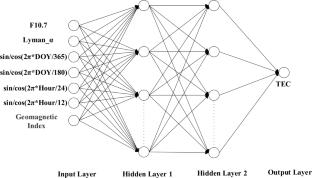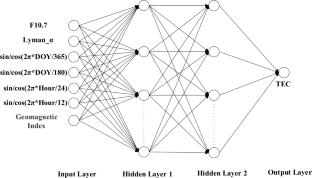基于BP神经网络的区域电离层TEC模拟:以华东地区为例
摘要
电离层中的总电子含量(TEC)经历了动态变化,主要受太阳辐射驱动,并受到包括地磁活动在内的一系列因素的影响。在这项研究中,我们利用反向传播(BP)神经网络进行TEC建模,并利用来自四个国际GNSS服务(IGS) GIM网格点(CA, BF, JN和HS)的12年(2008-2019)TEC数据,系统地研究了不同地磁指数对中国东部不同纬度TEC模型精度的影响。模型输入包括太阳活动指数(F10.7, Lyman- \(\alpha \))、TEC的周期变化(年、半年、日、半日)和地磁指数(Dst、Kp、Ap、AE),整合成一个两隐层网络(20×20节点)。地磁输入显著提高了TEC在中纬度地区的建模精度,而在低纬度地区仅产生了微小的改进。具体而言,在中纬度网格点(CA, BF),包括地磁指数将均方根误差(RMSE)降低了约7% (from 1.70 to 1.58 TECU) under geomagnetically quiet conditions. Moreover, the model effectively captured ionospheric responses during geomagnetic storms, accurately reproducing both positive and negative phases of ionospheric storms, as demonstrated by two representative events (October 25, 2011 and March 17, 2015). In contrast, at low-latitude grid points (JN, HS), the improvements were less pronounced, with less than 2% RMSE reduction under geomagnetically quiet conditions and only minor improvements during these ionospheric storm events. The optimized 20×20 BP neural network architecture achieved a favorable balance between accuracy and computational efficiency, providing useful insights for region-specific TEC modeling and reference for TEC forecasting.


The Total Electron Content (TEC) in the ionosphere undergoes dynamic variations, primarily driven by solar radiation and influenced by a range of factors including geomagnetic activity. In this study, we utilize a backpropagation (BP) neural network for TEC modeling and systematically investigate how different geomagnetic indices affect model accuracy across various latitudes in East China, using 12 years (2008–2019) of TEC data from four International GNSS Service (IGS) GIM grid points (CA, BF, JN, and HS). The model inputs include solar activity indices (F10.7, Lyman-\(\alpha \)), periodic variations in TEC (annual, semiannual, diurnal, semidiurnal), and geomagnetic indices (Dst, Kp, Ap, AE), integrated into a two-hidden-layer network (20×20 nodes). Incorporating geomagnetic inputs significantly improved TEC modeling accuracy at mid-latitudes and yielded only marginal improvements at low latitudes. Specifically, at mid-latitude grid points (CA, BF), including geomagnetic indices reduced the Root Mean Squared Error (RMSE) by ∼7% (from 1.70 to 1.58 TECU) under geomagnetically quiet conditions. Moreover, the model effectively captured ionospheric responses during geomagnetic storms, accurately reproducing both positive and negative phases of ionospheric storms, as demonstrated by two representative events (October 25, 2011 and March 17, 2015). In contrast, at low-latitude grid points (JN, HS), the improvements were less pronounced, with less than 2% RMSE reduction under geomagnetically quiet conditions and only minor improvements during these ionospheric storm events. The optimized 20×20 BP neural network architecture achieved a favorable balance between accuracy and computational efficiency, providing useful insights for region-specific TEC modeling and reference for TEC forecasting.

 求助内容:
求助内容: 应助结果提醒方式:
应助结果提醒方式:


